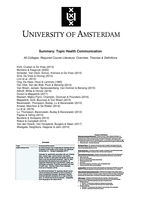Summary: Topic Health Communication
All Colleges, Required Course Literature, Overview, Theories & Definitions
Kohl, Crutzen & De Vries (2013)
Montano & Kasprzyk (2002)
Scheider, Van Osch, Schulz, Kremers & De Vries (2012)
Smit, De Vries & Hoving (2012)
Linn et al. (2012)
Ong, De Haes, Hoos & Lammes (1995)
Van Vliet, Van der Wall, Plum & Bensing (2013)
Van Weert, Jansen, Spreeuwenberg, Van Dulmen & Bensing (2010)
Althoff, White & Horvitz (2016)
Diviani & Meppelink (2017)
Mackert, Mabry-Flynn, Champlin, Donovan & Pounders (2016)
Meppelink, Smit, Buurman & Van Weert (2015)
Baranowski, Thompson, Buday, Lu & Baranowski (2010)
Kroese, Marchiori & De Ridder (2016)
Lu et al. (2016)
Lu, Thompson, Baranowski, Buday & Baranowski (2012)
Papies & Veling (2013)
Beullens & Schepers (2013)
Ridout & Campbell (2014)
Van den Heerik, Van Hooijdonk, Burgers & Steen (2017)
Westgate, Neighbors, Heppner & Jahn (2014)
, College 1
“Nothing is as practical as a good theory” – A systematic way to tackle a (health) problem.
But beware: a model is just a model! Limited representation of the real world.
The Theory of Reasoned Action (TRA, Montano & Kasprzyk, 2002)
Attitude toward behaviour: opinion, evaluation.
o Behavioural beliefs: advantages, disadvantages of the behaviour.
o Evaluation of behavioural outcomes: positive/negative, important/not important.
Subjective norm: norm within your social environment.
o Normative beliefs: e.g. your parents think you should eat healthy.
o Motivation to comply: may be low because you don’t want to listen to your parents.
The Theory of Planned Behaviour (TPB, Montano & Kasprzyk, 2002) adds:
Perceived behavioural control: ability to perform the behaviour.
o Control beliefs: e.g. I don’t have enough money to perform the behaviour.
o Perceived power: may be high, because no money limits you to perform the
behaviour.
Intention = the most important predictor of behaviour = the result of a conscious
consideration of pros & cons, important others’ opinion, and perceived control (except TRA).
Yet, behaviour isn’t always rational.
Computer-tailoring: based on personal information
Questionnaire > data file > software program > (feedback library) > tailored feedback.
Working mechanisms – behaviour change < use and engagement < information
processing < personal relevance.
Public health impact = effect * reach
Online health communication = high effect * high reach
Mass media communication = low effect * high reach
Health counselling = high effect * low reach
2





